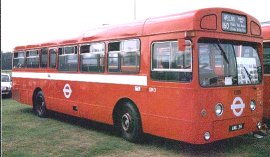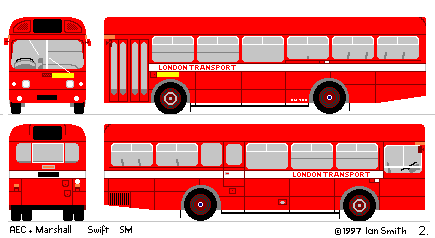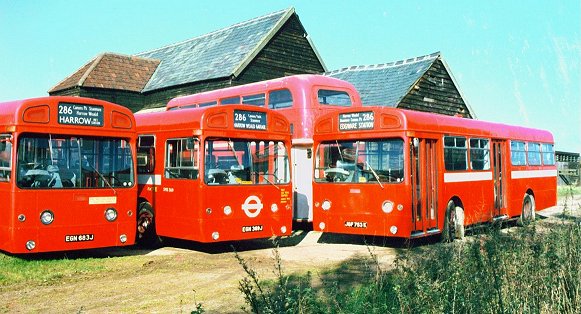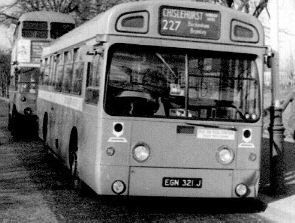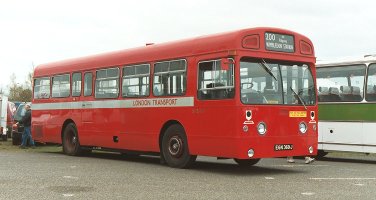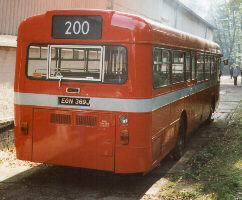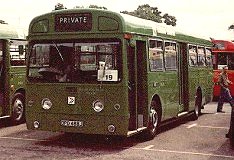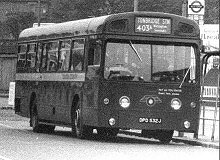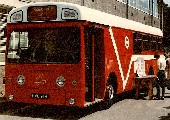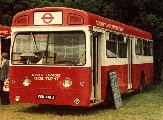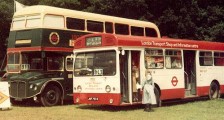
The LONDON TRANSPORT SwiftsThis page created on Notepad by Ian Smith, August 1997, updated 20th November 2004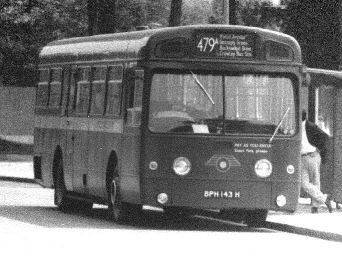
Contents
SM143 at Crawley (CY).
|
| Date | No. | Route | Garage | Type displaced |
|---|---|---|---|---|
| 24 Jan 70 | 160 | Catford (St.Dunstans)-Eltham-Welling (Mon-Sat) | TL Catford | RT |
| 24 Jan 70 | 160A | Lower Sydenham Stn-Catford-Eltham-Welling-Plumstead Garage(Sun) | TL Catford | RT |
| 18 April 70 | 270 | Richmond Stn-Twickenham-Teddington-Fulwell Garage | FW Fulwell | new |
| 18 April 70 | 132 | Eltham-Bexleyheath Garage-Slade Green | BX Bexleyheath | RT |
| 18 April 70 | 81 | Hounslow-Cranford-Heathrow Airport North-Colnbrook-Slough Stn | AV Hounslow | RM |
| 18 April 70 | 81B | Hounslow-Cranford-Heathrow Airport Central | AV Hounslow | RM |
| 13 June 70 | 245 | Golders Green-Childs Hill-Cricklewood-N.Wembley-Sudbury Town Stn (M-S) | W Cricklewood | |
| 13 June 70 | 245A | Golders Green-Pennine Drive-Cricklewood-N.Wembley-Sudbury Town Stn (Sun) | W Cricklewood |
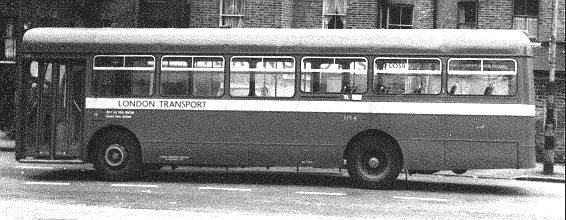
SM 4 at Catford (TL) for the 160. Photo, used with permission, by BusSpotter
Hounslow's SMs on the 81 group were displaced by dual door SMSs in January 1973, and moved to Poplar to replace the Strachan-bodied MBs on the 108 route through the Blackwall Tunnel.A year later, in January 1974, the opposite kind of displacement occurred: Bexleyheath's route 132 was converted to DMS, reducing serious overcrowding, with the SMs going to Fulwell to displace SMSs on route 90.
Two years later, the Fulwell SMs were replaced by SMDs, on the 90 in March 1976, and the 270 in April. After a trip to Poplar for fare-apparatus exchange they went on to Cricklewood in April, replacing MBs on route 268. Catford's SMs were replaced by SMDs in June, and went to Leyton for the 235.
SMS 51-100, (B33D+34)
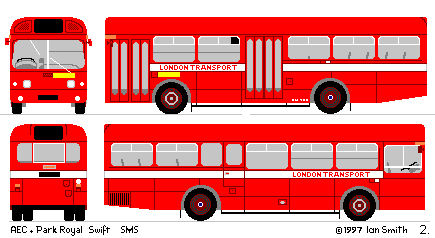 The second series, SMS51-SMS100 were bodied by Park Royal.
They had dual doors, with a split entrance. This divided the crowd:
the left door catered for those wanting the driver, or change,
while the right hand door gave entry to automatic fare machines.
It all worked fine in factory trials,
but the sensitive money-handling machines performed less well when jolted around in service:
weighing machines never work well under variable gravity!
When the machine didn't work the luckless passengers
were barred from reaching the driver, which slowed things even more.
Not surprisingly, the cognoscenti sooned learned not to play the slot machines in the chance of hitting the jackpot,
and entered via the driver's door (or sneaked in via the exit doors).
The second series, SMS51-SMS100 were bodied by Park Royal.
They had dual doors, with a split entrance. This divided the crowd:
the left door catered for those wanting the driver, or change,
while the right hand door gave entry to automatic fare machines.
It all worked fine in factory trials,
but the sensitive money-handling machines performed less well when jolted around in service:
weighing machines never work well under variable gravity!
When the machine didn't work the luckless passengers
were barred from reaching the driver, which slowed things even more.
Not surprisingly, the cognoscenti sooned learned not to play the slot machines in the chance of hitting the jackpot,
and entered via the driver's door (or sneaked in via the exit doors).
New Cross garage (NX) was the first recipient, on 18th April 1970,
for radial route 70 (Greenwich Church - Aldgate).
More followed on unlucky 13th June, at Edgware (EW).
The transition there was not helped by a shortage of ticket-rolls for the fare machines!
| Date | No. | Route | Garage | Type displaced |
|---|---|---|---|---|
| 18 April 70 | 70 | Greenwich Church - Surrey Docks - London Bridge Stn | NX New Cross | RT |
| 13 June 70 | 142 | Watford Junction - Bushey - Stanmore -Edgware( - Colindale) | EW Edgware | |
| 13 June 70 | 186 | Harrow-on-the-Hill - Wealdstone - Belmont Circle - Canons Park - Edgware Stn | EW Edgware | new |
| 13 June 70 | 286 | Harrow-on-the-Hill - Wealdstone - Harrow Weald - Stanmore - Canons Park - Edgware Stn | EW Edgware | new |
SMS369, 683 and 753 all display different 286 blinds whilst in preservation by Mick Overton in 1987. Photo, used by permission, by Mick Overton
London Country SM 101-148 (B38D+18)
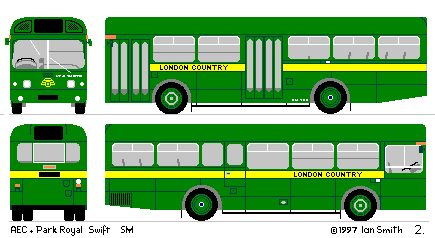 The new London Country, separated from London Transport in January 1970,
received its quota of Swifts, ordered by London Transport
before the nationalisation of the Country Area.
The new London Country, separated from London Transport in January 1970,
received its quota of Swifts, ordered by London Transport
before the nationalisation of the Country Area.
The Country Swifts, although dual-door, did not suffer the indignities of automatic fare collection: everyone paid the driver. Again, they were conceived as RT-replacements.
The first few started in June 1970 from Leatherhead(LH) on the 418 and 418A. More followed on 1st August, to Crawley (CY), Addlestone (WY) and Guildford (GF). They did look smart in the last LT Country Area livery of Lincoln green with canary yellow waist-band, (with London Country fleetnames and "flying polo" symbols of course). At Addlestone and Guildford they displaced the last seventeen of the Country area low-height double-deckers, the RLH class, that operated the 436, 461, 461A, 462, and 463 until the 31st July 1970. At Crawley they took over from RTs and RFs on local routes.
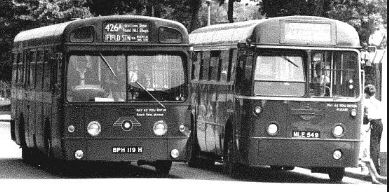
The old order and the new, for London Country. SM 119 at Crawley, alongside RF 549. The SM is a handsome bus. It was a pity that its performance did not live up to its appearance! RF 549 still looks reasonably modern, despite twenty years of service.
Click image for a larger picture.
Photo, used with permission, by BusSpotter
| Date | No. | Route | Garage | Type displaced |
|---|---|---|---|---|
| 27 Jun 70 | 418 | Kingston - Surbiton - Tolworth - Epsom - Leatherhead - Bookham Stn | LH Leatherhead | RT |
| 1 Aug 70 | 436 | Staines - Chertsey - Addlestone - New Haw - Woking - Burpham - Guildford | GF/WY | RLH |
| 1 Aug 70 | 436A | Staines - Chertsey - Addlestone - New Haw - Woking - Ripley | GF/WY | RLH |
| 1 Aug 70 | 461 | Staines - Chertsey - Addlestone - Weybridge - Walton-on-Thames | GF/WY | RLH |
| 1 Aug 70 | 461A | Botleys Park - Ottershaw - Addlestone - Weybridge - Walton-on-Thames | GF/WY | RLH |
| 1 Aug 70 | 463 | Guildford - Merrow - Woking - New Haw -Addlestone - Weybridge - Walton-on-Thames | GF/WY | RLH |
| 1 Aug 70 | 426A | Pound Hill - Three Bridges - Crawley - Ifield | CY Crawley | RT/RF |
| 1 Aug 70 | 476 | Crawley - Ifield | CY Crawley | RT/RF |
| 1 Aug 70 | 476A | Pound Hill South - Three Bridges - Manor Royal - Langley Green - Ifield | CY Crawley | RT/RF |
SMS 149-448 (B33D+34)
75 more dual-doored bodies by Marshall, and 225 by Park Royal followed during 1970-1 for Central Area use, displacing RTs - and Merlins - around the suburban fringes of London.SMSs joined SMs at Hounslow (AV) in September 1970 for new route 82 (Hounslow Bus Stn - Heathrow Airport - Hatton Cross - Hounslow West),
this being an extended version of the previously-SM operated 81B. SMs remained on the 81.
The end of October saw SMSs take over from Strachans-bodied Merlin MBs on the 107 at Enfield (E).
On this route they were treated as if they were SMs, having no automatic fare equipment,
and not using the centre doors.
Others arrived at Croydon (TC) for the 166 group, Thornton Heath (TH) for the 289,
and Elmers End (ED) for the 194, displacing RTs.
In November Willesden (AC) received seven to convert the 226 from RT operation.
| Date | No. | Route | Garage | Type displaced |
|---|---|---|---|---|
| 19 Sept 70 | 248 | Romford Stn-Roneo Corner-Hornchurch-Upminster Stn-Hall Lane- Upminster Park Estate-Cranham-Upminster Stn | RD Hornchurch | RLH |
| 19 Sept 70 | 248A | Upminster Stn-Corbets Tey | RD Hornchurch | RLH |
| 26 Sept 70 | 82 | Hounslow-Cranford-Heathrow Airport Central-Hatton Cross-Hounslow W. | AV Hounslow | SM (81B) |
| 31 Oct 70 | 107 | Queensbury Stn-Edgware-Elstree-Arkley-Barnet-Enfield-Ponders End | E Enfield | MB |
| 31 Oct 70 | 166 | Chipstead Valley-Coulsdon-Purley-E. Croydon-Addiscombe-Shirley- Beckenham Junc) | TC Croydon | RT |
| 31 Oct 70 | 166A | Chipstead Valley-Coulsdon-Purley-Croydon-Thornton Heath Garage | TC Croydon | RT |
| 31 Oct 70 | 194 | Forest Hill-Penge-Elmers End-Shirley-East Croydon-Croydon Airport | ED Elmers End | RT |
| 31 Oct 70 | 289 | Thornton Heath Garage-Addiscombe | TH Thornton Heath | RT |
| 7 Nov 70 | 226 | Golders Green Stn-Pennine Drive-Cricklewood-Harlesden-Park Royal | AC Willesden | RT |
Early January 1971 saw more omo conversions: Putney's route 85, Thornton Heath's routes 115/A, Stockwell's route 81 and Bromley's 227. At Putney RMs were displaced, while from Thornton Heath and Stockwell it was RTs.
On the 227 Swifts replaced not the usual RTs but RFs. The route suffered a low bridge under the Southern main line and over the River Ravensbourne at Shortlands station (Bromley), which dictated single deck operation on this busy route. A length constraint at termini at Penge and Chislehurst prevented use of the longer Merlins.
SMS 321 at Crystal Palace, brand new on the 227.
Note the flat fare symbols on the front, a visual reminder to waiting passengers to have the correct money available.
Click image for a larger picture.
Photo, used with permission, by BusSpotter
In mid-January the 125 at Finchley, 240/A at Edgware and 244 at Muswell Hill
were converted to SMS.
The Edgware conversion caused a change-round of SMS allocations
to get all of Edgware's SMSs to have the same type of afc equipment.
An extension of route 111 to Hampton Station to replace the withdrawn 211 (M-F)
saw more SMSs go to Hounslow for both 110 and 111, displacing MBSs to Harrow Weald.
At the end of the month
Merton converted back to single-deckers on the 200
SMS 369 was a Merton bus for its first seven years of servcice, so was no stranger to the 200 route. The bus has been beautifully preserved. It is seen at Cobham in October 1997, and again in April 2003.
| Date | No. | Route | Garage | Type displaced |
|---|---|---|---|---|
| 2 Jan 71 | 85 | Putney Bridge Stn - Roehampton - Kingston Vale - Kingston | AF Putney | RM |
| 2 Jan 71 | 115/A | Wallington - Hackbridge - Mitcham - Streatham - Thornton Hth Pond - Croydon Airport | TH Thornton Heath | RT |
| 2 Jan 71 | 181 | Streatham Garage - Tooting - Balham - Clapham - Stockwell - Vauxhall - Victoria | SW Stockwell | RT |
| 2 Jan 71 | 227 | Chislehurst - Bickley - Bromley - Beckenham - Penge - Crystal Palace | TB Bromley | RF |
| 16 Jan 71 | 125 | Winchmore Hill - Southgate - Whetstone - Finchley - Hendon - Golders Green Stn | FY Finchley | RT |
| 16 Jan 71 | 240/A | Golders Green Stn - Hendon - Mill Hill - Edgware Stn | EW Edgware | RT |
| 16 Jan 71 | 244 | Southgate Stn - Bounds Green - Muswell Hill Bdy | MH Muswell Hill | RT |
| 16 Jan 71 | 110 | Cranford - Heston - Hounslow - Hanworth -Twickenham Stn | AV HounslowHill | MBS |
| 16 Jan 71 | 111 | Hanworth - Whitton - Hounslow - Hampton Stn | AV HounslowHill | MBS |
| 30 Jan 71 | 200 | Raynes Park - Wimbledon - Mitcham | AL Merton | RT |
Mid-March 1971 saw SMSs go to Romford, to North Street to replace RTs on routes 103 and 294, and another bunch to Hornchurch for the 252. Later in the month Camberwell converted trunk route 188 from RT operation, Fulwell and Norbiton converted route 285 from RMs, Highgate introduced new route 239 and Croydon rationalised by converting the 233 from operation by FRM1 and XAs.
Catford took some SMSs from this batch for the 108B in April, while Stonebridge took the last Park-Royal bodied buses for the 112 in May.
| Date | No. | Route | Garage | Type displaced |
|---|---|---|---|---|
| 13 Mar 71 | 103 | North Romford - Romford - Becontree Heath - Dagenham - Rainham | NS North Street | RT |
| 13 Mar 71 | 294 | Lodge Lane Estate - Collier Row - Romford - Gidea Park - Hornchurch Stn | NS North Street | RT |
| 13 Mar 71 | 252 | South Hornchurch - Romford Stn - Collier Row | RD Hornchurch | RT |
| 27 Mar 71 | 188 | Greenwich Church - Deptford - Rotherhithe - Bermondsey - Elephant - Waterloo Stn - Aldwych - Euston | Q Camberwell | RT |
| 27 Mar 71 | 285 | Heathrow Airport Central - Hatton Cross - Feltham - Teddington - Kingston - New Malden | FW/NB | RM |
| 27 Mar 71 | 233 | West Croydon Stn - Roundshaw | TC | FRM/XA |
| 17 Apr 71 | 108B | Crystal Palace - Sydenham - Catford - Lewisham - Blackheath - Greenwich | TL | RT |
| 15 May 71 | 112 | Finchley - Neasden - Stonebridge Park - Hanger Lane - Ealing Broadway | SE | RT |
London Country SM 449-538 (B41D+15)
London Country took another 90 dual-doored SMs during 1971. In February Hatfield converted routes 303/A and 315/A from RT. Meanwhile Amersham and High Wycombe started to put SMs into service with crews in advance of the official omo conversion date (Feb.20th), in order to avoid recertifying RTs on routes 353 and 362/A.Stevenage received some in standard green and yellow livery in March, to convert the 809 to SM operation.
Four more went to Crawley in April when London Country took over more town services from Southdown, including the 475.
| Date | No. | Route | Garage | Type displaced |
|---|---|---|---|---|
| Feb 71 | 353 | Berkhamsted - Chesham - Amersham - Gerrards Cross - Slough - Windsor | MA Amersham | RT |
| Feb 71 | 362/A | Ley Hill - Chesham - Amersham - - High Wycombe | MA/HE | RT |
| 20 Feb 71 | 303/A | New Barnet - Potters Bar - Welwyn Garden City - Knebworth - Stevenage - Hitchin | HF Hatfield | RT |
| 20 Feb 71 | 315/A | Hatfield - Welwyn Garden City - Welwyn - Kimpton/Woolmer Green | HF Hatfield | RT |
| 20 Mar 71 | 809 | Stevenage Stn - Stevenage - Bedwell - Chells | SV Stevenage | RT |
| 24 Apr 71 | 475 | Crawley - Handcross | CY Crawley | Southdown |
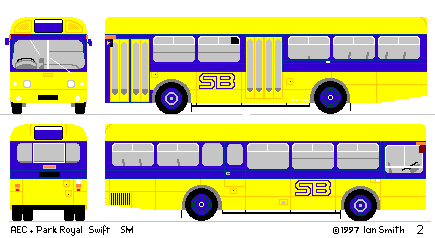
The 809 was not to last long. In July it was the centrepiece of a new venture in Stevenage,
when it was converted to be the first Superbus route. The buses wore a startlingly different livery:
yellow with blue relief.
The buses were collected at Garston or Dorking before the inauguration, and completed in their new livery.
Initially there were only five Swifts (SM495-499) to go with two Metro-Scanias,
but success quickly brought the repainting of further Swifts.
The rest of the batch of Swifts went to Swanley, Dartford, Chelsham and Dunton Green, displacing RTs and RFs across a wide swathe of the South-East sector. Routes involved were the 401/A, 402, 423/A/B, 453, 467 and 491.
(left): SM488 at a rally (right):SM532 on the 403 to Tonbridge.
Click on images for larger pictures.
Photos, used with permission, by BusSpotter
| Date | No. | Route | Garage | Type displaced |
|---|---|---|---|---|
| 3 July 71 | 401 | Upper/Lower Belvedere - Bexleyheath - Bexley - Dartford - Shoreham - Sevenoaks | SJ/DT | RT |
| 3 July 71 | 401A | Bexleyheath/Bexley/Dartford - Joydens Wood Estate | DT Dartford | RT |
| 3 July 71 | 402 | Bromley North Stn - Farnborough - Dunton Green - Sevenoaks - Tonbridge | DG Dunton Green | RT/RF |
| 3 July 71 | 423 | Wrotham - West Kingsdown - Farningham - Swanley - Wilmington - Dartford - Watchgate - Longfield | SJ/DT | RT |
| 3 July 71 | 423A/B | Wells Factory/Littlebrook- Dartford - Watchgate | SJ/DT | RT |
| 3 July 71 | 453 | Chelsham - Warlingham - Whyteleafe - Caterham | SJ/DT | RT |
| 3 July 71 | 467 | Sidcup - Foots Cray - Bexley - Crayford - Dartford - Wilmington- Horton Kirby | SJ/DT | RT |
| 3 July 71 | 491 | Lower Belvedere - Barnehurst - Perry Street - Crayford - Dartford - Wilmington- Horton Kirby | DT | RT/RF |
| 31 July 71 | SB | Stevenage - Chells | SV | 809 SM |
SMS 539-838 (B33D+34)
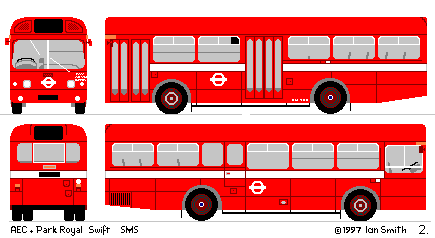
London Transport found itself with another three hundred Swifts arriving during 1971 and 1972, the last buses from AEC for LT. These arrived as LT was starting its next attempt at modernisation and RT replacement - the Daimler Fleetline DMS - trying to build on its one-man operation experience gained with the single-deckers.
The Swifts again went to various parts of the system, replacing some RTs
and standing in for failed Merlins and earlier Swifts:
they were not proving any more reliable than their immediate predecessors.
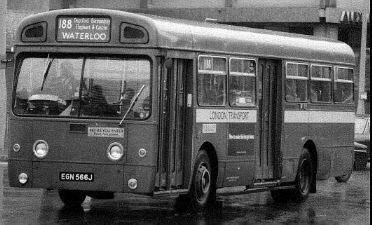
SMS 566 at Elephant & Castle on the 188 service to Waterloo.
Photo, used with permission, by BusSpotter
The first of LT's MCW-bodied SMSs arrived while Park Royal was tailing off its batch.
LT tried to keep them separate in their initial allocations. The first MCWs went to Highgate in the March 1971 programme,
for the new 239 route. They were followed in April by the conversion of back-street route 236
from crew-operated RF - the last route using crew RFs. Dalston and Leyton were both involved.
West Ham converted the 238 from RM operation at the same time.
May saw more RTs displaced at Alperton and Southall with routes 92 and 274. Southall also gained new route 208, while Streatham acquired new route 249.
On 3rd July Swifts replaced Merlins on Peckham route P1, allowing a cover float of MBSs to be set up
for the MBS repaint programme. RT replacement continued at Loughton (167), Barking (179) and Potters Bar (299).
At the end of the month Upton Park joined in, losing RTs from the 147.
| Date | No. | Route | Garage | Type displaced |
|---|---|---|---|---|
| 27 Mar 71 | 239 | Tuffnell Park - Kings Cross - Waterloo | HT Highgate | new |
| 17 Apr 71 | 236 | Leytonstone Stn-Hackney Wick-Dalston-Finsbury Pk Stn (-Golders Green Stn) | D/T | RF |
| 17 Apr 71 | 238 | Stratford Broadway-Upton Park-East Ham-Barking-Goodmayes-Little Heath | WH West Ham | RM |
| 15 May 71 | 92 | Southall Garage - Greenford - Sudbury - Wembley | ON/HW | RT |
| 15 May 71 | 274 | Hayes - Yeading - Greenford - West Ealing - Ealing Broadway | HW Southall | RT |
| 15 May 71 | 208 | Hayes Stn - Hanwell | HW Southall | new |
| 15 May 71 | 249 | Crystal Palace - Clapham Junction (- Battersea) | AK Streatham | new |
| 3 July 71 | P1 | New Cross - Surrey Docks - Bermondsey - New Cross | NX New Cross | MBS |
| 3 July 71 | 167 | Debden Broadway - Loughton - Buckhurst Hill - Chigwell - Barkingside - Ilford | L Loughton | RT |
| 3 July 71 | 179 | Chingford Stn - Woodford Wells - Sth Woodford - Gants Hill - Ilford - Barking | BK Barking | RT |
| 3 July 71 | 299 | Southgate Stn - Cockfosters - Potters Bar - South Mimms - Borehamwood | PB Potters Bar | RT |
| 31 July 71 | 147 | Redbridge Stn - Ilford - East Ham | U Upton Park | RT |
During the back end of 1971 the omo conversion process continued unabated, using both DMSs and SMSs. In September the latter included routes 57 (Merton), 91 (Turnham Geen), 116 (Hounslow) and 231 (Enfield), all converted from RT to SMS. Norbiton started new route 211. SMSs also took over from omo RFs on the 210 route. At the end of October Harrow Weald lost its RTs from the 114, and Upton Park Routemasters from the 162. Uxbridge changed from RTs on the 222 in December, and Southall started new route 195. Croydon put one SMS onto new (Saturdays only) route 233A.
| Date | No. | Route | Garage | Type displaced |
|---|---|---|---|---|
| 18 Sep 71 | 57 | Kingston-Norbiton-Raynes Park-Wimbledon-Merton-Tooting-Streatham | AL Merton | RT |
| 18 Sep 71 | 91 | Wandsworth Bridge - Hammersmith - Turnham Green - Hounslow West | V Turnham Grn | RT |
| 18 Sep 71 | 116 | Staines - Bedfont - Hounslow Heath - Hounslow (- Great West Rd) | AV Hounslow | RT |
| 18 Sep 71 | 211 | Kingston - Hampton Court - E.& W.Molesey - Walton-on-Thames | NB Norbiton | new |
| 18 Sep 71 | 231 | Turnpike Lane Stn - Enfield Town - Forty Hill | E Enfield | RT |
| 18 Sep 71 | 210 | Golders Grn Stn-Hampstead Hth-Kenwood-Highgate-Archway Stn- Finsbury Park | HT/MH | RF |
| 31 Oct 71 | 114 | Ruislip Lido - Ruislip - South Harrow - Harrow - Wealdstone - Harrow Weald | HD Harrow Weald | RT |
| 31 Oct 71 | 162 | Wanstead-Forest Gate-Upton Park-East Ham-Barking-Mayesbrook Park | U Upton Park | RM |
| 4 Dec 71 | 222 | Hounslow-Cranford-Harlington-Heathrow North-West Drayton- Uxbridge Stn | UX Uxbridge | RT |
| 4 Dec 71 | 195 | Charville Lane Estate - Greenford (-Perivale) | HW Southall | new |
| 4 Dec 71 | 233A | Roundshaw Estate - Wallington (Sats) | TC Croydon | new |
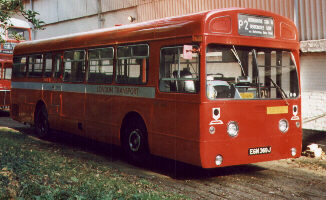 Early 1972 saw the last of the SMS class being delivered.
In January North Street in Romford converted routes 66 and 66B from RT.
Route 12 was split, with SMSs operating the 12A between Peckham and South Croydon.
Early 1972 saw the last of the SMS class being delivered.
In January North Street in Romford converted routes 66 and 66B from RT.
Route 12 was split, with SMSs operating the 12A between Peckham and South Croydon.
The February changes were more complex,
There were not enough new SMSs for the February programme, but more were found by converting Putney's route 85 to DMS operation.
This allowed Fulwell's route 90 to be converted from RT, and route P2 to receive SMSs in place of MBSs at New Cross.
There remained enough new buses to convert Hounslow's last RT routes, the 203 and 203A, in March.
SMS 369 at Cobham Bus Museum in October 1997, wearing P2 blinds.
Photo by Ian Smith.
| Date | No. | Route | Garage | Type displaced |
|---|---|---|---|---|
| 8 Jan 72 | 66/B | Leytonstone - Newbury Park - Romford - Gidea Park - Harold Wood Stn / Hornchurch Stn | NS North Street | RT |
| 8 Jan 72 | 12A | Peckham - Dulwich - Penge - Addiscombe - South Croydon Garage | ED Elmers End | RT |
| 5 Feb 72 | 90 | Staines - Sunbury - Hanworth - Twickenham - Richmond - Kew Gardens Stn | FW Fulwell | RT |
| 5 Feb 72 | P2 | Rotherhithe - Surrey Docks - Rotherhithe | NX New Cross | MBS |
| 11 Mar 72 | 203/A | Hounslow - Hatton Cross - Bedfont - Staines / Ashford Stn | AV Hounslow | RT |
October 1972 saw the start of a repaint programme for SMs and SMSs. To provide sufficient slack in the allocations for the programme, Enfield lost its SMSs on the 107, these being replaced by DMSs.
Through the seventies
Both London Transport and London Country had problems with their Swifts, possibly because of the mechanical excellence of the previous generation. The RT and RF era had built up an expectation in management that buses would BE reliable, and their longevity and mechanical simplicity had produced a maintenance regime that just was not prepared for the new buses. More complex systems, interlocks, indirect cooling systems and electronics were not in the Manchester screwdriver handbook of bus maintenance. So too few maintenance staff were overwhelmed by buses that did what most buses do, while management were also caught in the trap, unable to magic new technical staff, and to some extent throwing new buses at the problem. These buses had not had the five year gestation periods of the RT and RM classes, (and remember they too had had horrific problems in their early days).
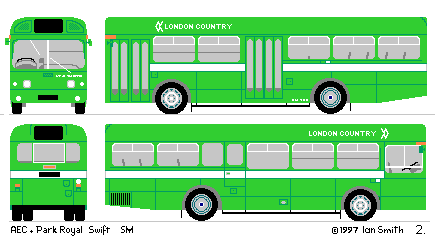
But also in this period British manufacturing industry went through a period of serious malaise, which resulted in a chronic lack of spare parts. Buses went into store in droves due to lack of spares. In December 1973 alone London Country put twenty-three of its SMs into store!
The writing really appeared on the wall when the Merlins and Swifts proved not to be amenable to the Aldenham style of periodic reconstructions, and when Leyland Nationals appeared at the right moment. The Merlin/Swift classes were doomed to a short existence with the London companies.
In the meantime they appeared on a variety of bus duties. Liveries were updated, with the roundel replacing fleetnames in London, and NBC green washing over the Country fleet.
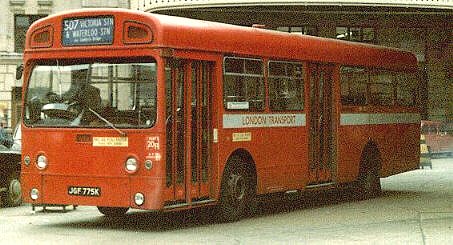
SMS 775 at Victoria Station on the 507 Red Arrow service to Waterloo, 23/01/81.
Photo, used with permission, by BusSpotter
The SMD debacle
The automatic fare collection equipment continued to cause problems and delays, and SMS routes were subjects to many complaints about overcrowding and "cattle-truck" conditions. So in 1974 an experiment was made on SMS 75: to remove the afc equipment and install more seats, both doubling the single seats in the forward section and utilising the afc space. At the same time the centre exit doors were sealed shut. SMS75 went to Fulwell to join the SMs on route 90, and was reclassified as SMD75 in April 1976 after it had been joined by more conversions.In 1975 a programme was adopted to modify another 115 buses, with the idea of replacing the MBs and MBSs. Route 103 was converted to DMS in August 1975, with the idea of converting route 90 to SMD operation by the end of the month. In practice the released SMSs all went to patch up gaps in SMS allocations due to non-availability. It was 1976 before wide-spead SMD conversions got underway. In practice only 104 were done. The modified buses were classified SMD. That the experimental nature of SMD75 - just sealing the doors - was repeated on this larger batch, rather than installing a proper panel, floor and window, was indicative of the rather desperate state of affairs in LT at the time.
It was February 1976 before SMSs (released from route 244 at Edgware) headed to Poplar garage for conversion, and March before they took over from SMs at Fulwell on route 90. Fulwell suffered again in April, with more SMDs arriving for the 270. Catford was the next garage to receive them, again in place of SMs. The displaced SMs went to Leyton, along with more SMDs, to replace MBs on the 235.
The SMD programme petered out when it became obvious that no-one really wanted the modified buses. Their seven year certicates were rapidly expiring and only a few achieved an overhaul to extend their public existence. Some stayed in store after modification. Some found work as Aldenham staff buses - and ventured out as far as Reigate and St.Albans, but even these were swiftly replaced by some of the first batch of red SM Swifts. The SMDs were withdrawn from public service by mid 1978.
Decline and Withdrawal
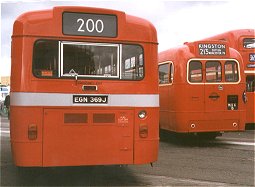 The unaltered SMS were not in better state. First sales were in October 1976,
with the buses just six years old.
In the Central Area they were replaced as rapidly as possible by Leyland Nationals.
The Swifts had had a repaint in 1974, but not an overhaul. By 1977 their seven year tickets were expiring,
and perforce many had to go into store to await their opportunity for a light overhaul.
Victoria garage's basement bulged, and other places in the system with covered accommodation did too.
The light overhauls, taking about two months each, recertified the buses,
and gave them another couple of years of London service in most instances.
The unaltered SMS were not in better state. First sales were in October 1976,
with the buses just six years old.
In the Central Area they were replaced as rapidly as possible by Leyland Nationals.
The Swifts had had a repaint in 1974, but not an overhaul. By 1977 their seven year tickets were expiring,
and perforce many had to go into store to await their opportunity for a light overhaul.
Victoria garage's basement bulged, and other places in the system with covered accommodation did too.
The light overhauls, taking about two months each, recertified the buses,
and gave them another couple of years of London service in most instances.
Swifts took over from Merlins on Red Arrow duties,
but this was only until the Mark II Nationals took over in 1981.
The last Swift on ordinary bus duties went from Edgware in January 1981,
and the last Red Arrow went in July. In the Country they rapidly dwindled during 1981 too.
Most were sold. Other users around the country made good use of some of them, and others went abroad
- to all corners of the globe. Malta and Belfast were two places where many found good homes.
Many gave good service, when given the TLC that London's harassed bus engineers didn't have the time to give.
 A page of Merlins and Swifts in service after London.
A page of Merlins and Swifts in service after London.
![]()
LONDON TRANSPORT SERVICE FLEET
Some of the LT Swifts were converted for the service fleet in their latter days:
SMD 91 became a Video-bus, with some of the forward window-spaces blanked over;
SMS 300 became a mobile classroom;
SMD 441 became a Mobile Recruitment Centre;
SMS 730 became a Mobile Recruitment Centre;
SMS 753 became a Shop and Information Centre for use at Rallies and Events.
Click image for larger pictures.
Photos, used with permission, by BusSpotter
![]()
Preservation / survivors
Just eighteen of the 838 seem to have survived in the UK, some in working preservation: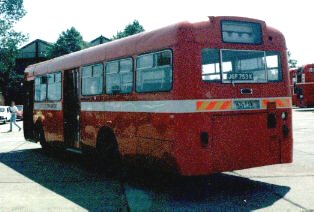
- SM 1 : Blue Triangle (in store, 2000)
- SM 3 : Blue Triangle (in store, 2000)
- SM 30: Emsworth & District
- SM 32: Blue Triangle (in store, 2000)
- SMD 88: Blue Triangle
- SMD 91: preserved, ex Video Bus
- SMS 97: preserved, London
- SM 106: preserved by RM835 group
- SM 114: preserved, London
- SM 120: "Nigel the Newsbus": caravan
- SMS158: preserved
- SMS320: Blue Triangle (in store, 2000)
- SMS369: preserved, Cobham Museum
- SMS443: Blue Triangle (in store, 2000)
- SM 498: Willy's Wheels: Film Location Vehicle
- SM 502: preserved
- SMS637: Emsworth & District
- SMD753: preserved, West Wickham
SMS 753, previously a LT recruiting bus, now restored to its former condition and
livery. Re-registered too - an American plate?. Click image for a larger picture.
Photo, used with permission, by BusSpotter
![]()
 Merlins and Swifts in service after London.
Merlins and Swifts in service after London.
 Swift histories
Swift histories
 photo refs
photo refs
 Bus Stop
Bus Stop
 Merlins.
Merlins.
 Swifts.
Swifts.
 SMW.
SMW.
![]()
